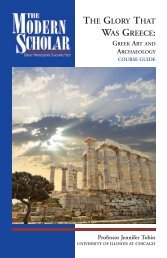The Trojan War in Homer and History - Recorded Books
The Trojan War in Homer and History - Recorded Books
The Trojan War in Homer and History - Recorded Books
Create successful ePaper yourself
Turn your PDF publications into a flip-book with our unique Google optimized e-Paper software.
LECTURE ELEVEN<br />
Lecture 11:<br />
Carl Blegen <strong>and</strong> the City of Troy VIIa<br />
<strong>The</strong> Suggested Read<strong>in</strong>g for this lecture is Michael Wood’s In Search of<br />
the <strong>Trojan</strong> <strong>War</strong>.<br />
Carl Blegen, of the University of C<strong>in</strong>c<strong>in</strong>nati, did not believe that Troy VIh was<br />
the city that the Mycenaeans captured. Accord<strong>in</strong>g to Blegen, not only had<br />
Schliemann been <strong>in</strong>correct <strong>in</strong> th<strong>in</strong>k<strong>in</strong>g that Troy II was the city of Priam, but<br />
his successor Dörpfeld had also been <strong>in</strong>correct <strong>in</strong> th<strong>in</strong>k<strong>in</strong>g that Troy VI was<br />
the city of Priam. <strong>The</strong> very next city, known to archaeologists as Troy VIIa,<br />
was not really a new city, Blegen said; it was simply Troy VIh rebuilt—the<br />
walls were patched up <strong>and</strong> the houses restored. Even the pottery <strong>and</strong> other<br />
rema<strong>in</strong>s left from everyday life rema<strong>in</strong>ed the same.<br />
In Blegen’s experience—<strong>and</strong> it was considerable—when the material culture<br />
of a city rema<strong>in</strong>ed essentially the same, it frequently meant that the population<br />
had also rema<strong>in</strong>ed essentially the same. In other words, it looked to<br />
Blegen as if the survivors of the earthquake that leveled Troy VIh had simply<br />
picked up the pieces of their lives, rebuilt, <strong>and</strong> carried on as before. If<br />
Dörpfeld had not already labeled this new city “Troy VIIa,” Blegen may well<br />
have preferred to call it “Troy VIi” <strong>in</strong>stead, for it was simply the next phase of<br />
this long-lived sixth city, which had already been built <strong>and</strong> rebuilt <strong>in</strong> a series<br />
of different phases for more than five hundred years by this po<strong>in</strong>t. <strong>The</strong>re is<br />
even Mycenaean pottery found <strong>in</strong> Troy VIIa, which would make no sense if<br />
the Mycenaeans had completely destroyed the city at the end of Troy VI <strong>and</strong><br />
left it a smok<strong>in</strong>g ru<strong>in</strong>, as <strong>Homer</strong> describes; <strong>in</strong>stead, it looks like the<br />
Mycenaeans were still trad<strong>in</strong>g with the <strong>Trojan</strong>s, or at least their pottery was<br />
still reach<strong>in</strong>g the city of Troy VIIa.<br />
However, this city was also a bit unusual. Although there was very little left<br />
still to excavate up on the citadel of Troy, Blegen made the best of what had<br />
been left to him <strong>and</strong> proceeded to make a series of spectacular discoveries.<br />
Blegen noticed that the large <strong>and</strong> prosperous houses located with<strong>in</strong> the<br />
citadel of Troy VIh were rebuilt <strong>in</strong> Troy VIIa with many party walls subdivid<strong>in</strong>g<br />
their <strong>in</strong>teriors, as if many families were now liv<strong>in</strong>g where a s<strong>in</strong>gle family unit<br />
had lived previously. He also noticed other <strong>in</strong>dications that the population of<br />
this fortified citadel had suddenly exp<strong>and</strong>ed to many times its previous size. A<br />
prime <strong>in</strong>dication of this expansion was the many storage jars—pithoi, as they<br />
are known—not only with<strong>in</strong> the houses but also buried beneath the floors, so<br />
that only their tops were visible <strong>and</strong> accessible. By so bury<strong>in</strong>g these jars, the<br />
<strong>in</strong>habitants were not only able to keep some perishable items cold, even <strong>in</strong><br />
an era that had no refrigeration, but were also able to double or even triple<br />
their capacity for stor<strong>in</strong>g gra<strong>in</strong>, w<strong>in</strong>e, olive oil, <strong>and</strong> other necessities of life.<br />
46






